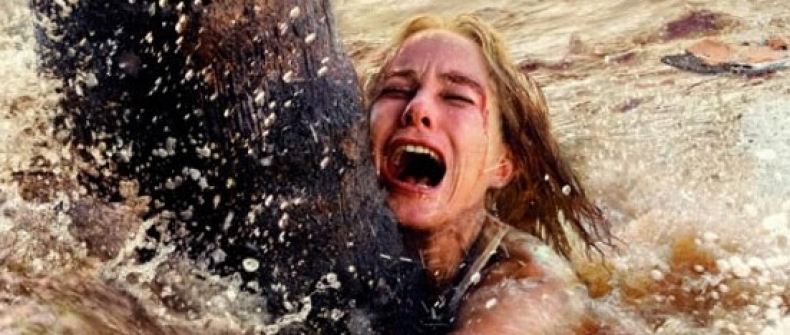
“The Impossible”
Having a limited tolerance for triumph-of-the-human-spirit stories, I took one look at the trailer for The Impossible — about a European family that miraculously survived the 2004 Indian Ocean tsunami — and placed it somewhere near the bottom of my to-see list. A movie about vacationing white Westerners overcoming a disaster that killed more than 200,000 people, most of them natives of Indonesia, Sri Lanka, India, and Thailand? No thanks. Making matters worse, the real-life Spanish family has been turned into a bunch of Brits, the parents played by the blindingly blonde Naomi Watts and Ewan McGregor. Though I admired Spanish director Juan Antonio Bayona’s previous feature, The Orphanage, I couldn’t imagine how this new one could be anything other than crass and exploitive.
Wrong on both counts. As it turns out, The Impossible is a hugely effective, even exhilarating melodrama — like something Spielberg might’ve made in one of his more inspired periods. (It has quite a few similarities to his War of the Worlds, in fact.) I think many of the sharpest reviewers have underrated The Impossible because, like me, they’re conflicted about endorsing yet another white-people-in-peril movie. But we critics can be an overly sensitive bunch, and this film deserves to be cut some slack. In interviews, Bayona has acknowledged he had to Anglicize the leads in order to get financing, so I’m not sure what more he could’ve done there. And while it’s unfortunate movies like this so seldom adopt non-white perspectives, the choice of protagonists doesn’t, in this case, invalidate what’s on screen. Bayona has the rare ability to make you feel whatever his characters are feeling, and unless you’re one of those types who believes rich white people can’t merit sympathy — that pain and suffering are the exclusive domain of the oppressed — you’ll be as caught up as I was.
It helps that Bayona has a simple, unintrusive style, that he lets you interpret shots for yourself. The pre-tsunami scenes — unremarkable moments in which the Bennet family enjoy their resort vacation — can be taken at face value, as the happy calm before the storm, or they can be interpreted as subtle interrogations of Western privilege: the kids with their expensive toys, the bedtime readings of Goodnight Moon, the picture-perfect paper lantern ceremony. I wasn’t sure how Bayona himself felt about these scenes, but it didn’t matter. Sometimes being a good filmmaker means knowing when not to express oneself.
The tsunami, when it comes, is terrifying, and maybe the best sequence of its kind ever filmed. McGregor and the three boys are roughhousing in the pool and Watts is reaching for a piece of paper torn loose from a book when, all of a sudden: silence. A scattering of birds. Nervous glances. Then, beyond the tree tops, a brackish wall rises and begins flattening everything. Watts barely has time to close her eyes before it hits. I know some people consider this type of thing exploitive — disaster and trauma turned into spectacle. But this is part of the primal appeal of movies (hell, of stories); we want to experience what we hope never to experience in life, and as long as it’s done with respect and some gravity I think it’s more than valid. Clint Eastwood recreated the same disaster in his woeful Hereafter, and though his special-effects team did a creditable job, it felt like a Universal Studios ride — the minute it was over you wanted to shout, “Again! Again!” The tsunami here, shot mostly from Watts’s perspective, is harrowing. Instead of emphasizing the neat-o mechanics of destruction, Bayona emphasizes the horror of watching loved ones swept away. We’re right there with Watts as she tries to swim to one of her boys, the floating cars and telephone wires just blurry impediments. Bayona does justice to the emotional experience of calamity.
After the tsunami, when the separated family goes in search of one another, we adopt the perspective of the eldest son, 10-year-old Lucas (the excellent Tom Holland), who becomes his mother’s caretaker after she suffers a brutal gash to her leg. It’s a smart move, because it mirrors the way natural disaster (presumably) turns us all into awed, scared kids. And Bayona and his screenwriter, Sergio G. Sánchez, show a real feel for the mindset of a boy on the verge of adulthood. At one point, Lucas tries to tell his mom about her leg wound, but when she turns around he notices one of her breasts is exposed. Suddenly, he’s torn between wanting to go to her and wanting to look away in embarrassment. There are many unexpectedly fine, perceptive moments such as this, and they make accusations of exploitation feel totally unwarranted. (Just a few scenes later, Lucas and his exhausted mom take refuge in a tree with a little boy not yet old enough to talk, and the boy starts patting Watts’s hair, then running his small hand ever-so-softly over her arm. It’s hard to tell if the moment was scripted, but something about it gets to you either way, and it puts the hard-sell, tear-jerking tactics of most other movies to shame.)
The Impossible may not contain great intellectual depths, but it contains great depths of feeling, and it mixes spectacle and emotion so that both heighten the other. In this way it’s a direct descendent of the early silents. Watts trying to save her boy from the deadly currents is like Lillian Gish escaping over the ice floes in Way Down East, and the family’s eventual reunion is like the great homecoming scene in Birth of a Nation. The images have a primal power, and to dismiss them as sentimental or manipulative is almost to dismiss the whole art of moviemaking. Several other recent films — Hotel Rwanda, Rescue Dawn — had these same qualities, and they, too, were lambasted. The Impossible marks the difference between sentiment and earned emotion, a distinction too few critics bother to make anymore.
____
Scott MacDonald writes about cinema for Toronto Standard. You can follow him on Twitter at @scottpmac. He just started tweeting, so be gentle with him.
For more, follow us on Twitter @TorontoStandard and subscribe to our newsletter.














